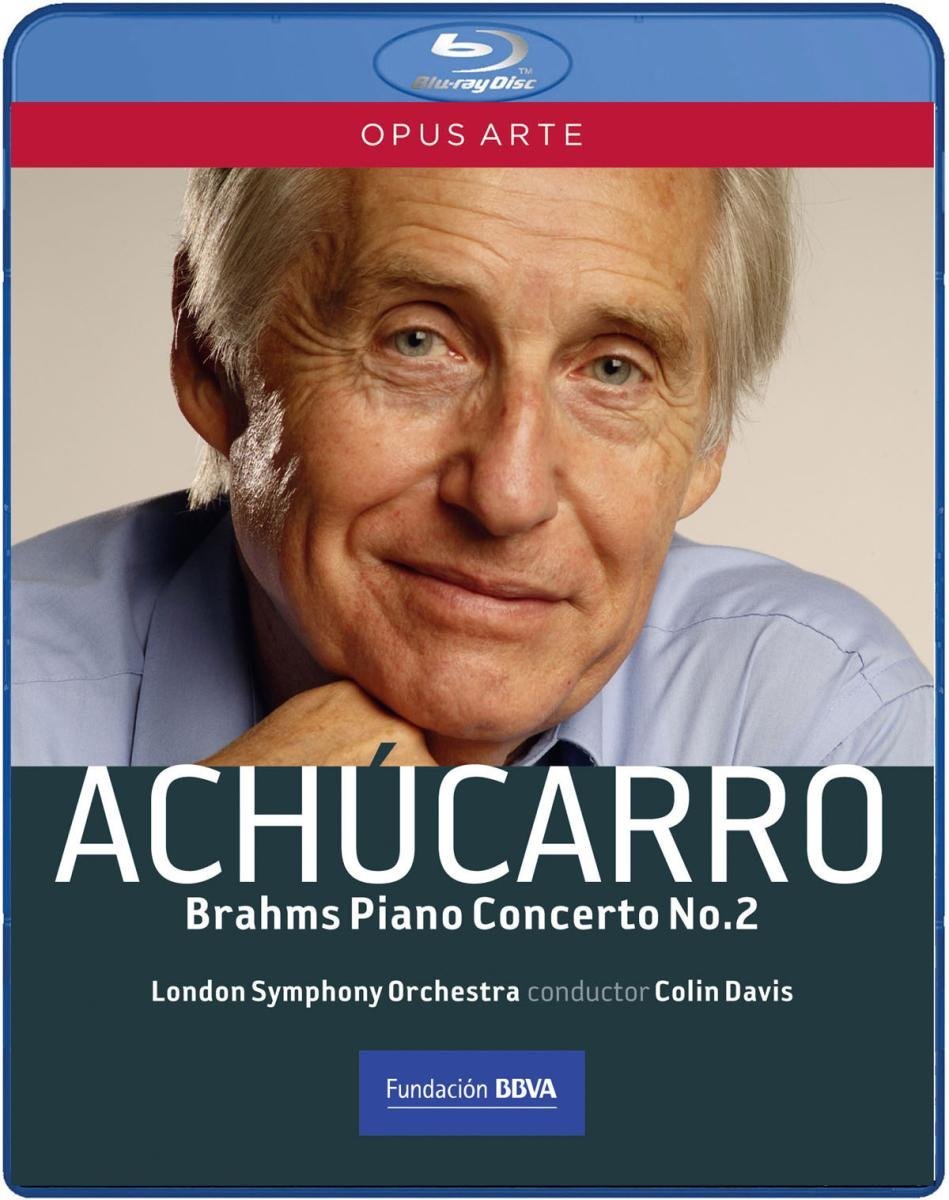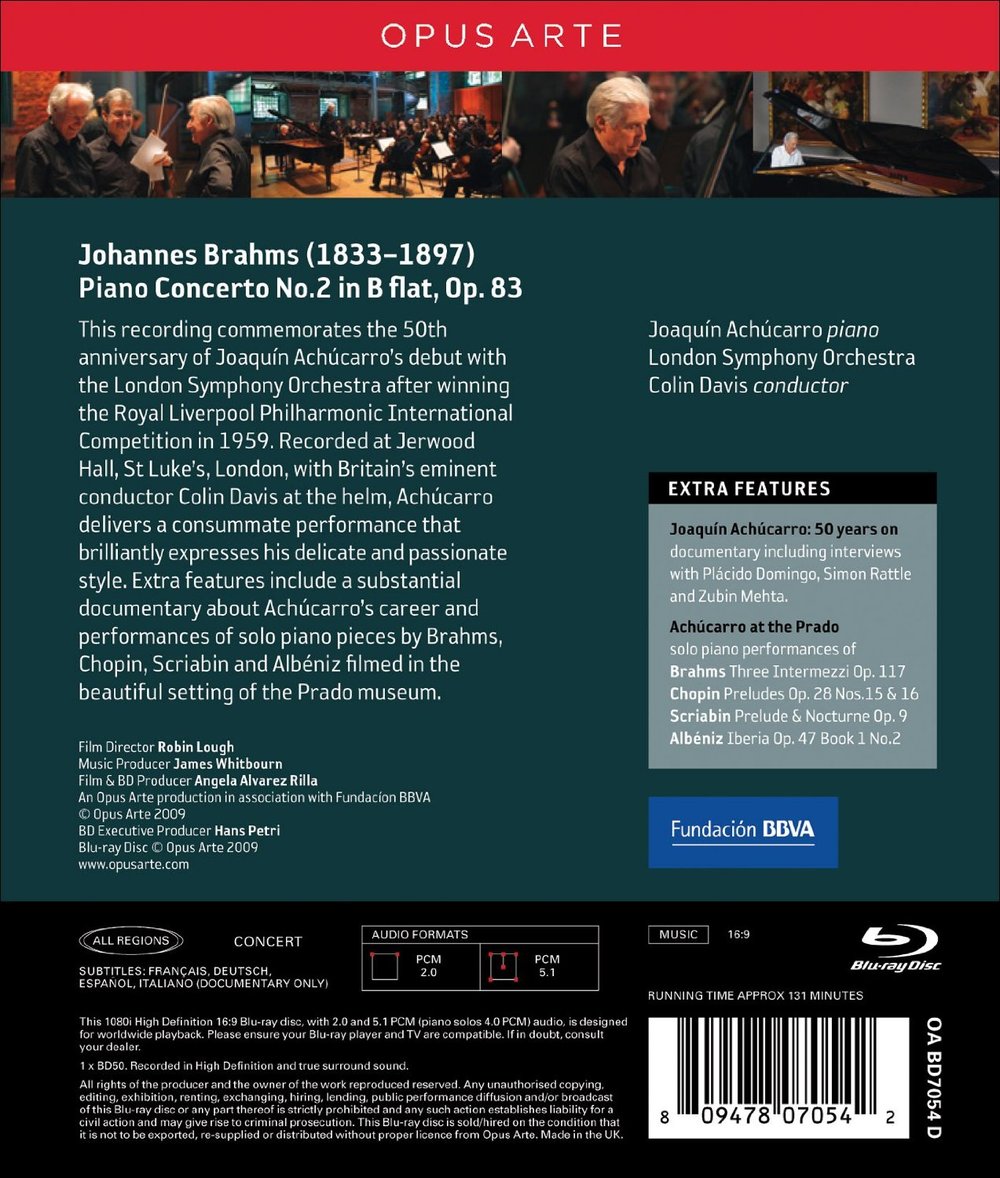

This Achúcarro title includes:
Brahms Piano Concerto No. 2 recorded in studio on May 26, 27, and 28, 2009 at the Jerwood Hall in London.
There is also a recital of about 36 minutes with the following shorter pieces recorded in Room 64 of the Prado Museum in Madrid at an unidentified time:
Brahms Intermezzo No. 2 (Three Intermezzi Op. 117)
Brahms Intermezzo No. 2 (Three Intermezzi Op. 117)
Brahms Intermezzo No. 3 (Three Intermezzi Op. 117)
Chopin Prelude No. 15
Chopin Prelude No. 16
Scriabin No. 1 Prelude (Op. 9 for Left Hand)
Scriabin No. 2 Nocturne (Op. 9 for Left Hand)
Albéniz Suite Iberia Op. 47 Book 1 No. 2 El Puerto
Colin Davis conducts the Brahms Piano Concerto No. 2 with the London Symphony Orchestra to commemorate the 50th anniversary of Achúcarro's debut with the LSO. Directed for TV by Robin Lough. Released 2010, disc has 5.1 PCM sound.Grade: C-
This is an update of a review I originally wrote in August 2011. What we have here are two studio recordings made by an artist who was in 2009 fast approaching 80. It's heart-warming to see him get through it. Most anyone would kill to be able to play as well as Achúcarro. But in my humble opinion, Achúcarro is not competitive in either portion of this disc with CD recordings from leading pianists such as Marc-André Hamelin and Arcadi Volodos. But even now, in May 2015, this is still the only HDVD of the Brahms Piano Concerto No. 2.
I originally graded this title D because it smacks so pungently of being a trophy or vanity project. My friends say Opus Arte and Colin Davis would not taint their brands this way. But here are the things that still bother me: the lack of a live audience, the three days it took to shoot the Brahms Concerto No. 2 (how many takes?), the sponsorship of Fundación BBVA in promoting the home town boy, the glamour-puss cover photo, the "this-is-your-life" center spread in the keep box booklet, and the vacuous, self-serving, so-called "documentary" that gobbles up 43 minutes of the disc. I suggest there's nothing wrong with a vanity project — it's just that if the motivation is to honor someone (especially yourself) with a publication, aren't you supposed to give it away rather than try to sell it?
Now on the other hand, a lot of people seem to like this title. Scott Cantrell praised it in the Dallas Morning News and International Record Review gave it an "IRR Outstanding" award. I will also praise Achúcarro for showing us how effective it can be to to do a studio recording under a dress code. Ordinarily, musicians at a studio recording session wear jeans, tee shirts, hair-rollers, filp-flops, etc. But for this recording, everyone wore a crisp black open-throat shirt and matching bottoms. The decommissioned, renovated church was startlingly pretty as lit for the sessions and no trash was or distracting gear was allowed. The result was warm, pleasing, respectful, and professional. I've never seen a recording session like this before: maybe Achúcarro is leading us in an auspicious direction with this concerto video.
Here are some screenshots of the studio recording session with the LSO. Note in the first two shots how neat and attractive everything is with stylish lighting designed to look great to the video audience. More importantly, cameras are placed to give excellent whole-orchestra views of the performance:
This video shooting of a single concerto took place over three days! This had to be exhausting for the members of the LSO, who often look rather grim in the video. Colin Davis couldn't stand on his feet for all this time, and in the next shot you see him resorting to a chair:
And the star winds up looking drained:
Of course, in a concerto, the cameras will mostly be aimed at the soloist when he's playing. Here the camera crews have trouble keeping the keyboard looking rectangular:
Here's a beautiful shot of the orchestra in tutti while Achúcarro rests:
This piece has a great part for the principal cellist. But from this angle, the dramatic lighting doesn't work:
But another camera gets the job done from a better angle:
There are many whole-orchestra shots in the video, but no effort was made to show the larger string sections in isolation. There are some small-section shots from a camera located on the left side of the orchestra:
I'll not diagnose the dread disease of DVDitis for this video. But there are too many inane shots of the conductor and too many pointless instrument-only shots like these:
I'll conclude that this is a decent but unimpressive recording of the Brahms Piano Concerto No. 2 by an aging performer who was able to arrange for a pretty video.
I would not extend any praise, however, to the recital segment of this title. The recital consists of pieces that seem to be carefully chosen as safe to play. They are mostly slow and simple with but a single brilliant run. And each piece is on a separate mini-clip followed by a blank screen for several seconds, so there's no feeling of continuity.
But as to the venue for the recital, Achúcarro proves he has pull. He got permission to play at the Prado in Room 64 directly in front of three of the most famous Spanish paintings, all by Goya: the "The Shooting of May 3rd," the "Second of May 1808" (or "Charge of the Mamelukes"), and "Ferdinand VII in his Robes of State." Come to think of it, "The Shooting of May 3rd" is one of the most important paintings ever done by anyone because it is often considered to be the first modern painting in Western art.
So during the entire recital I kept praying, "Oh, please yet us see these painting in all their glory and in detail in high-definition images!" No dice. All we get are out-of-focus fragments while Achúcarro does encores. Here are some screenshots that show how frustrating this is. If you got to play at the Prado, wouldn't you at least wear a necktie?
It's hard to avoid this feeling: Achúcarro is trying boost himself (perhaps the best-known Spanish pianist working in 2009) by basking in the light of the greatest artist in Spanish history. I condemn Achúcarro and the Prado for this sacrilege. But the Prado can be redeemed if they will just allow someone to make a HDVD called "Treasures of the Prado" so everyone in the world can see their Goyas in high-def. And Achúcarro can be redeemed if he will help raise funds to make a Prado documentary.
So what to make overall of this curious disc? No one (other than Goya) will be harmed by watching this. Colin Davis had to resort to the captain's chair, but I don't think he ever went to sleep and fell off. Achúcarro's playing is not exciting, but he does have a knack for for making things look pretty, which is important in the HDVD era.
I still don't like this disc. In the documentary, both Achúcarro and Sir Rattle make a case that Achúcarro here salvages the lost art of playing the piano slowly. Fish, don't bite that fly! Here's why: what we are really seeing here is that the old Narcissus has tottered and fallen in the pool and he's starting to drown in his dotage. I should stick to the D grade, meaning don't buy this unless you have a special reason. But, I could be wrong. Out of respect for the beauty of the video (not the sound) of the LSO in the church and Achúcarro's reputation as a great piano teacher, I'm bumping the grade up to a "C-."
Well, YouTube has the entire Brahms Concerto No. 2 up in HD:
OR


















